|
| |
Archives
katrina
Watch this video all the way through.
MTP VIDEO: Jefferson Parish Prez -- in Tears -- Begs for FEMA Help
thanks to War and Piece
Do You Know What It Means to Lose New Orleans?
by Anne Rice
|
WHAT do people really know about New Orleans?
Do they take away with them an awareness that it has always been not only a great white metropolis but also a great black city, a city where African-Americans have come together again and again to form the strongest African-American culture in the land?
The first literary magazine ever published in Louisiana was the work of black men, French-speaking poets and writers who brought together their work in three issues of a little book called L'Album Littéraire. That was in the 1840's, and by that time the city had a prosperous class of free black artisans, sculptors, businessmen, property owners, skilled laborers in all fields. Thousands of slaves lived on their own in the city, too, making a living at various jobs, and sending home a few dollars to their owners in the country at the end of the month.
This is not to diminish the horror of the slave market in the middle of the famous St. Louis Hotel, or the injustice of the slave labor on plantations from one end of the state to the other. It is merely to say that it was never all "have or have not" in this strange and beautiful city.
| |
[more]
thanks to BookNotes
This is still America
|
We in this nation, whether born here, brought here by our parents, or drawn here as adults, soon realize the uniqueness of this place in the world. Sheltered from ancient wars, distant from the quarrels that created them, a climate as close to a garden of eden as any you will find, rich in natural treasures for the spirit and the body. Even those who have been locked out of sharing in this richness have seen it - it is why America has spawned so many successful rebellions against tyranny and injustice: because almost nowhere else does a full and equal share of society mean so much.font>
Katrina has shaken that faith, it has done so first in its scale, but also in its aftermath in our response. It has been a century since an American city died.
| |
[more]
This email covers some of the health problems the gulf coast faces:
[IP] Hurricane Katrina Analysis - CFR Global Health Program
thanks to Steve Gilliard's News Blog
The Feds are STILL refusing assistance!!!!!!
|
NGOs are still being held at the borders of NOLA and other affected areas. Refugees are often being bused directly past these staging zones to the processing centers in TX.
| |
[more]
thanks to Steve Gilliard's News Blog
Northern Command isn't happy
|
Because Northern Command oversees all active-duty military operations inside the United States, it's also responsible for organizing the relief operations on the Gulf Coast. There are early indications, however, that NorthCom officials aren't entirely pleased with the orders they've received of late from the president.
| |
[more]
Why FEMA Was Missing in Action
Most of the agency's preparedness budget and focus are related to terrorism, not disasters.
thanks to War and Piece
photography
High precision industrial age souvenirs
|
If against all expectations, Wim Wenders were to make another good film, set on dusty highways, in cheap motels and provincial coffee shops – these could be his heroes: two strangers in Alabama, sometime in the seventies, lovers, driven by one obsession. They've been waiting for the right light for weeks, just the right amount of cloud, to photograph the recently closed blast furnace at the local steelworks, just as they have photographed a hundred other blast furnaces before. It's a fight against the sun and the clock. In the evenings the man stands in a windowless shower room of a seedy five-dollar motel and develops the films while the woman prepares dinner on the gas stove. And again they'll have to wait for a day when the sun burns less mercilessly, a day, they fear, which could come too late.
The blast oven is up for demolition any day, only a lone trade unionist who they met the previous evening at the bar in "Logan's Roadgrill", seems still to have any hope. The government, a new investor, any one could step in at the last moment and save the region from decline. The strangers know better: the only thing that will remain are their pictures.
Bernd and Hilla Becher have taken thousands of them over the last 50 years. Photographs of winding towers and cooling towers, of silos, lime kilns and blast furnaces, of coal bunkers and gravel plants. They are the souvenirs of a world recently lost.
| |
[more]
thanks to Conscientious
The site below is a frames site. (Bad! Bad!) Select the Bernd and Hilla Becher link. The pictures are presented in a slide show with Flash. (Bad! Bad!) The pictures are great. (Good! Good!)
Bernd and Hilla Becher
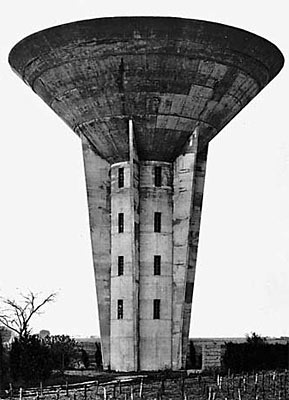
[more]
a tale of two cities
Tomgram: Iraq in America
The Perfect Storm and the Feral City
|
In the meantime, what we know from Katrina is that, in George Bush's new America, we are no longer capable, as a civilian society, of rescuing ourselves. Even the more civilian part of our military is gone. The Louisiana and Mississippi National Guard, after all, are mainly in Iraq, feeling, I'm sure, mighty helpless right now, while chaos reigns in their home cities. Thank you, George. Mission Accomplished!
Before the Iraq War, it was already evident that the State Department -- the foreign policy equivalent of a civilian effort -- was atrophying. (Administration officials were, after all, starving that beast too.) "Diplomacy," such as it was, was being conducted with other nations ever more regularly by our military proconsuls like our Centcom commander in the Middle East on a military-to-military basis. A grim wag suggested to me recently that the only way New Orleans would have gotten some quick action was if the administration had renamed Katrina "Osama," claimed it left behind weapons of mass destruction (as it may, in fact, have), and then invaded the city.
When an administration which has long believed that the resort to force should be the initial impulse behind any policy finally acts, force is unsurprisingly all it knows. If what we've observed in the last week is the response of the Bush administration to an essentially predictable civilian catastrophe, then imagine how prepared it is, after these four years of "homeland security," for an unpredictable one. Or what about, for instance, just another massive hurricane in this age of Xtreme weather? After all, though you can't find a word in the papers about it at the moment, we are only halfway through the fiercest, longest hurricane season in memory. We should be scared. Very scared.
In the end, this country remains in a powerful state of denial on two major matters which help explain why the elevation of George Bush and his cronies was no mistake. We are now a highly militarized society in all sorts of ways that any of us could see, but that is seldom recognized or discussed (except when the threat of base closings sends specific communities into a panic). Unrecognized and unconsidered, the militarized nature of our society is likely in the future to prove both dangerous and highly destructive. Right now, we are a weakened superpower wired for force and force alone -- and if Iraq has shown us one thing, it's that, when it comes to solving human problems of any sort, military force is highly overrated.
| |
[more]
relic art
Roadside Relics:
Vintage Neon Signs of Arizona
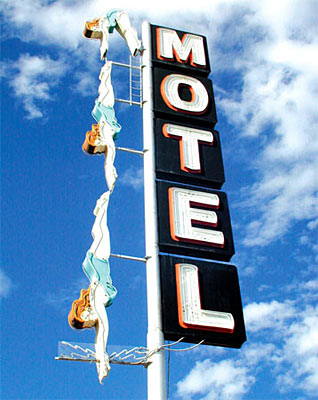
[more]
thanks to J-Walk Blog
energy
The Katrina Crisis
A hurricane produces an integrated energy disaster.
|
Man's technical ingenuity has collided with nature's rage in the Gulf of Mexico, and the outcome has been an integrated energy disaster. The full scope will not be understood until the waters recede, the damage to platforms and refineries is assessed, and the extent of damage to underwater pipelines from undersea mudslides is determined. Yet what has happened is on a scale not seen before, and the impact of the price spikes and dislocations will roll across the entire economy. Even as we confront the human tragedy, the consequences will also force us to think more expansively about energy security, and to focus harder on a matter which other events have already emphasized: the need for new infrastructure and investment in our energy sector.
What makes it an integrated crisis is that the entire energy supply system in the region has been disabled, and that the parts all depend upon each other for recovery. If the next weeks reveal that the losses are as large as some fear, this would constitute one of the biggest energy shocks since the 1970s, perhaps even the biggest. Unlike the crises of the '70s or the Persian Gulf crisis of 1990-91, this does not involve just crude oil: It includes natural gas, refineries and electricity.
| |
[more]
thanks to The Oil Drum
film size

bigger
gordy's image archive index
Life has been a little complicated and my photography focus has been putting together a photography kit and darkroom and not much time shooting. That's why there haven't been any additions to my image archive. This is an oldy but goody. I shot this in 1973. It was one of my first large format images. I'm excited about it because this was scanned from a 5x7 negative. My Epson 2450 will scan an area around 4"x9". Not quite enough for scanning a 5x7. I've been waiting for a new scanner that will scan 5x7 but that isn't happening. I scanned this in two sections and used Panavue Image Assembler to stitch it together. It worked great! I haven't cleaned it up yet. I didn't have the cleanest darkroom then and it's been beat up a little over the years but I wanted to see if I could scan 5x7. There goes another excuse not to shoot 5x7.
I've mentioned films size before. The larger the negative the better quality the print. There is better tonality and less grain. In car engines it is said that there is no substitute for cubic inches. In photography there is no substitute for square inches.
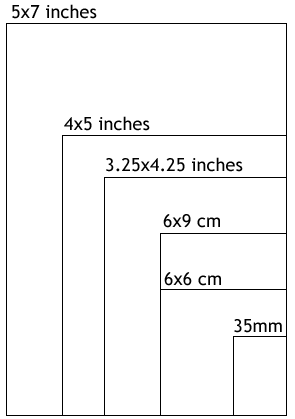
I've posted this before. These are the formats I can shoot or will be able to shortly. This graphic doesn't quite show the entire picture. Here is one that does. The graph shows the square inches of each format
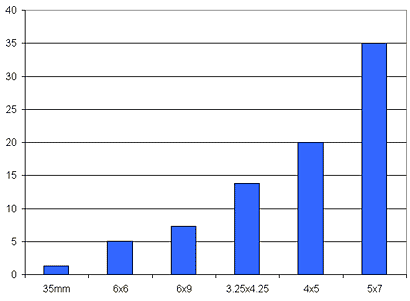
As a point of reference, For around $3,000 you can get a digital camera that will do as good, or better, than 35mm. For over $20,000 you can get a digital camera as good as 6x6cm. Thats a long way from 4x5 or 5x7. Here is a section from the picture at the top. It's taken at the end of the Fire Dept Connection sign. The lens I used was nothing special and not nearly as sharp as my process lenses.
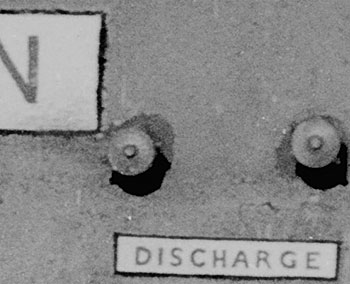
That's why I want to shoot large format.
remember iraq?
U.S. the New Saddam
by Eric Marolis
|
The most important news from Iraq last week was not the much ballyhooed constitutional pact by Shias and Kurds, nor the tragic stampede deaths of nearly 1,000 pilgrims in Baghdad.
The U.S. Air Force's senior officer, Gen. John Jumper, stated U.S. warplanes would remain in Iraq to fight resistance forces and protect the American-installed regime "more or less indefinitely." Jumper's bombshell went largely unnoticed due to Hurricane Katrina.
Gen. Jumper let the cat out of the bag. While President George Bush hints at eventual troop withdrawals, the Pentagon is busy building four major, permanent air bases in Iraq that will require heavy infantry protection.
Jumper's revelation confirms what this column has long said: The Pentagon plans to copy Imperial Britain's method of ruling oil-rich Iraq. In the 1920s, the British cobbled together Iraq from three disparate Ottoman provinces to control newly-found oil fields in Kurdistan and along the Iranian border.
| |
[more]
thanks to BookNotes
image circles
Lenses don't make rectangular images. They make circular images. Lenses on 35mm and medium format cameras make an image circle just large enough to cover the film. It's quite a bit different in large format. With a large format view camera it's important to not ony cover the film but to have extra for lens and back movements. And large format cameras come in a variety of sizes. I've been collecting a variety of lenses, mostly process lenses, and had a general idea of what the lens coverage was but wanted to see it for myself, so to speak. So I cut up some cardboard and taped it together (with a few iterations) to make Gordy's Grand Image Circle Measuring Device®.
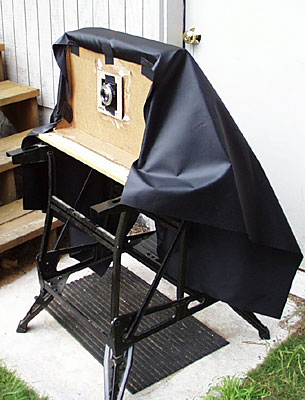
The base is a Black and Decker work bench. The bellows/dark cloth is nylon pack cloth. My old dark cloth really wasn't that dark so I went to Island Fabrics in Freeland and asked for an opaque black cloth. The nylon pack cloth was a little over $10 for a yard of 60 inch wide material. I will try it as a dark cloth for the Burke & James. I like it. No light gets through. It's a little stiff which is nice. And it's waterproof!
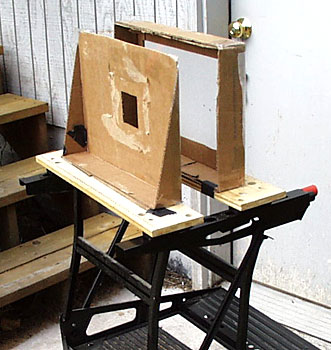
The Black and Decker work bench is a marvelous device. The front part of the bench can be located in three positions and the aft part is moved by screws turned by two handles.
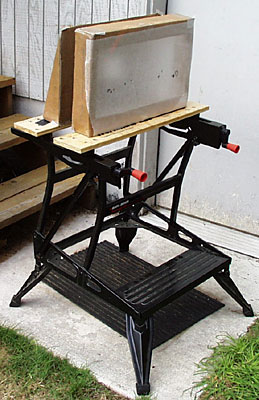
I used waxed paper to focus on. The image size is 16" x 8 1/2". The size was determined by a box I had handy and the width of the wax paper. I focus with the two orange handles. Just turn them around and the back moves back and forward. The dark cloth covered three sides and I stuffed some garbage bags in the bottom to cut the light. My lenses were mostly light process lenses and this worked fine. It's a bit wobbly but served it's purpose. I didn't put on my two heavy lenses (10" Elgeet and 21 1/4" Kodak) since they would have probably collapsed the front standard.
Some day I may make a more sturdy plywood version. I think there are some interesting possibilties for making a real camera out of one of these work benches. A cheap ultra large format either lensed or with a pinhole. Could be interesting. And cheap.
So what did I find out? Well, there was good news and not so good news.
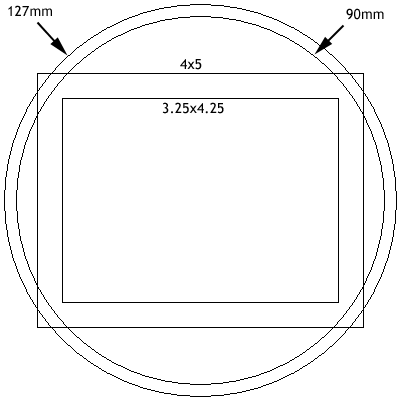
Both my 127mm Kodak Ektar and 90mm Wollensak don't quite cover 4x5. Bummer. But they do cover 3.25x4.25 which is the size of my Speed Graphic where the 90mm was going to end up eventually.
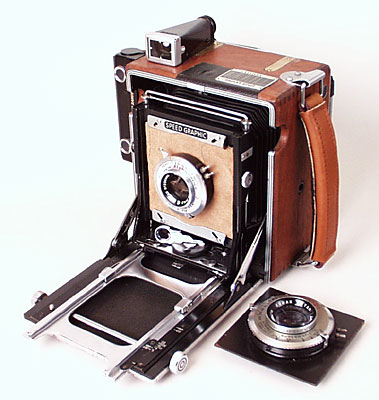
I built a temporary cardboard lens board for the Speed Graphic and it works fine. I thought it might see the bed but it doesn't seem to so I won't have to drop it. I will need to make a scale on the bed for the 90mm so I can scale focus it. The 127mm and 90mm are equivalent to 42mm and 30mm on the Speed Graphic.
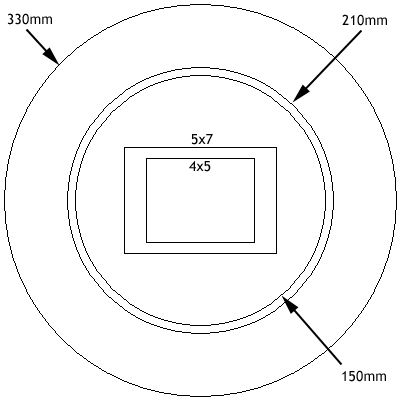
My 150mm Graphic Kowa, 210mm Schneider G-Claron leave lots of movement on the 5x7. The 330mm actually covers more that the 18". The 18" was all that my back showed. The 10" Elgeet is probably between the 210mm and 330mm lenses in coverage. The 21 1/4" Kodak would probably cover the side of a house.
|
|
|
|













